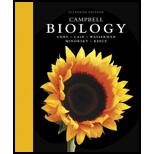
Concept explainers
How did Stanley Miller's experiments support the idea that, even at life's origins, physical and chemical laws govern the processes of life?
To review: Miller’s experiment formed the basis of the idea that origin of life and its processes are governed by physical and chemical laws.
Introduction: In 1953, Stanley Miller set up an experiment with conditions resembling those present on the early Earth. The possibility of organic compound formation was investigated under simulated conditions. He used a mixture of gases such as hydrogen, methane, ammonia, and water vapor in his experiment and passed sparks through the mixture of gases. After reactions, a number of compounds were identified in the mixture and many of them were organic compounds.
Explanation of Solution
Miller synthesized many organic compounds in his abiotic experiment by simulating the chemical and physical conditions that were present in the early Earth before the starting of life. . Abiotic experiments are those that do not involve in any material derived from living organisms. Miller’s experiment involved only physical and chemical phenomenon. Water was kept in a flask and was heated. The vapor generated was passed through a mixture of gases and sparks were generated to mimic lightning. A condenser was used to cool the hot gases and collected for analysis. These chemical and physical processes led to the formation of organic compounds that are commonly found in living organisms. Before Miller’s experiment, organic compounds were thought to be formed only by living organisms and life was believed to be a phenomenon not governed by physical and chemical sciences.
Miller’s experiment showed that life might have originated under abiotic conditions present in the early Earth. This discovery led to the conclusion that physical and chemical laws played an important role in the origin of life and are essential in life processes.
Want to see more full solutions like this?
Chapter 4 Solutions
Campbell Biology (11th Edition)
Additional Science Textbook Solutions
Laboratory Manual For Human Anatomy & Physiology
Campbell Essential Biology (7th Edition)
Microbiology Fundamentals: A Clinical Approach
Human Physiology: An Integrated Approach (8th Edition)
Physics for Scientists and Engineers: A Strategic Approach, Vol. 1 (Chs 1-21) (4th Edition)
- please fill in the empty sports, thank you!arrow_forwardIn one paragraph show how atoms and they're structure are related to the structure of dna and proteins. Talk about what atoms are. what they're made of, why chemical bonding is important to DNA?arrow_forwardWhat are the structure and properties of atoms and chemical bonds (especially how they relate to DNA and proteins).arrow_forward
- The Sentinel Cell: Nature’s Answer to Cancer?arrow_forwardMolecular Biology Question You are working to characterize a novel protein in mice. Analysis shows that high levels of the primary transcript that codes for this protein are found in tissue from the brain, muscle, liver, and pancreas. However, an antibody that recognizes the C-terminal portion of the protein indicates that the protein is present in brain, muscle, and liver, but not in the pancreas. What is the most likely explanation for this result?arrow_forwardMolecular Biology Explain/discuss how “slow stop” and “quick/fast stop” mutants wereused to identify different protein involved in DNA replication in E. coli.arrow_forward
- Molecular Biology Question A gene that codes for a protein was removed from a eukaryotic cell and inserted into a prokaryotic cell. Although the gene was successfully transcribed and translated, it produced a different protein than it produced in the eukaryotic cell. What is the most likely explanation?arrow_forwardMolecular Biology LIST three characteristics of origins of replicationarrow_forwardMolecular Biology Question Please help. Thank you For E coli DNA polymerase III, give the structure and function of the b-clamp sub-complex. Describe how the structure of this sub-complex is important for it’s function.arrow_forward
 Biology (MindTap Course List)BiologyISBN:9781337392938Author:Eldra Solomon, Charles Martin, Diana W. Martin, Linda R. BergPublisher:Cengage Learning
Biology (MindTap Course List)BiologyISBN:9781337392938Author:Eldra Solomon, Charles Martin, Diana W. Martin, Linda R. BergPublisher:Cengage Learning Human Heredity: Principles and Issues (MindTap Co...BiologyISBN:9781305251052Author:Michael CummingsPublisher:Cengage Learning
Human Heredity: Principles and Issues (MindTap Co...BiologyISBN:9781305251052Author:Michael CummingsPublisher:Cengage Learning Human Biology (MindTap Course List)BiologyISBN:9781305112100Author:Cecie Starr, Beverly McMillanPublisher:Cengage Learning
Human Biology (MindTap Course List)BiologyISBN:9781305112100Author:Cecie Starr, Beverly McMillanPublisher:Cengage Learning Concepts of BiologyBiologyISBN:9781938168116Author:Samantha Fowler, Rebecca Roush, James WisePublisher:OpenStax College
Concepts of BiologyBiologyISBN:9781938168116Author:Samantha Fowler, Rebecca Roush, James WisePublisher:OpenStax College
 Principles Of Radiographic Imaging: An Art And A ...Health & NutritionISBN:9781337711067Author:Richard R. Carlton, Arlene M. Adler, Vesna BalacPublisher:Cengage Learning
Principles Of Radiographic Imaging: An Art And A ...Health & NutritionISBN:9781337711067Author:Richard R. Carlton, Arlene M. Adler, Vesna BalacPublisher:Cengage Learning





